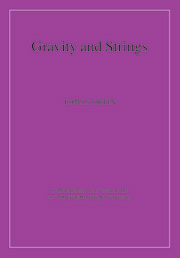Book contents
- Frontmatter
- Contents
- Preface
- Part I Introduction to gravity and supergravity
- Part II Gravitating point-particles
- Part III Gravitating extended objects of string theory
- 14 String theory
- 15 The string effective action and T duality
- 16 From eleven to four dimensions
- 17 The type-IIB superstring and type-II T duality
- 18 Extended objects
- 19 The extended objects of string theory
- 20 String black holes in four and five dimensions
- Appendix A Lie groups, symmetric spaces, and Yang–Mills fields
- Appendix B Gamma matrices and spinors
- Appendix C n-Spheres
- Appendix D Palatini's identity
- Appendix E Conformal rescalings
- Appendix F Connections and curvature components
- Appendix G The harmonic operator on ℝ3 × S1
- References
- Index
20 - String black holes in four and five dimensions
Published online by Cambridge University Press: 20 February 2010
- Frontmatter
- Contents
- Preface
- Part I Introduction to gravity and supergravity
- Part II Gravitating point-particles
- Part III Gravitating extended objects of string theory
- 14 String theory
- 15 The string effective action and T duality
- 16 From eleven to four dimensions
- 17 The type-IIB superstring and type-II T duality
- 18 Extended objects
- 19 The extended objects of string theory
- 20 String black holes in four and five dimensions
- Appendix A Lie groups, symmetric spaces, and Yang–Mills fields
- Appendix B Gamma matrices and spinors
- Appendix C n-Spheres
- Appendix D Palatini's identity
- Appendix E Conformal rescalings
- Appendix F Connections and curvature components
- Appendix G The harmonic operator on ℝ3 × S1
- References
- Index
Summary
Following our general plan, in the previous chapter we have started to see classical solutions that describe the long-range fields generated by configurations of extended objects in string/M theory. In general, the solutions do not reflect some of the characteristics of the brane configuration which may be understood as “hair,” but in many cases of interest (in general, in the presence of unbroken supersymmetry), given a classical supergravity solution, we can tell which brane configurations give rise to it. This is in itself a very interesting development, but there is more, because, if the brane configurations only involve D-branes, they can be associated with two-dimensional CFTs (string theories) over which we have good control. Furthermore, each of the branes considered here (D- or not D-) has a worldvolume supersymmetric field theory associated. All this allows us to relate supergravity configurations to QFTs whose degrees of freedom can be understood as the microscopical degrees of freedom of the quantum (super)gravity theory contained in string/M theory. This is, roughly speaking, the basis of the AdS/CFT correspondence and generalizations [170, 679] and also the basis for the microscopical computations of BH entropies [870], the subject of this final chapter.
In this chapter we are going to present N = 2A/B, d = 10 SUEGRA solutions associated with configurations of extended objects of type-II superstring theories that lead to BH solutions of maximal d = 5, 4 SUEGRAs (N = 4, d = 5 and N = 8, d = 4) (Section 20.2). The association can be understood as a strong–weak-coupling limit (see Figure 20.1).
- Type
- Chapter
- Information
- Gravity and Strings , pp. 573 - 590Publisher: Cambridge University PressPrint publication year: 2004



